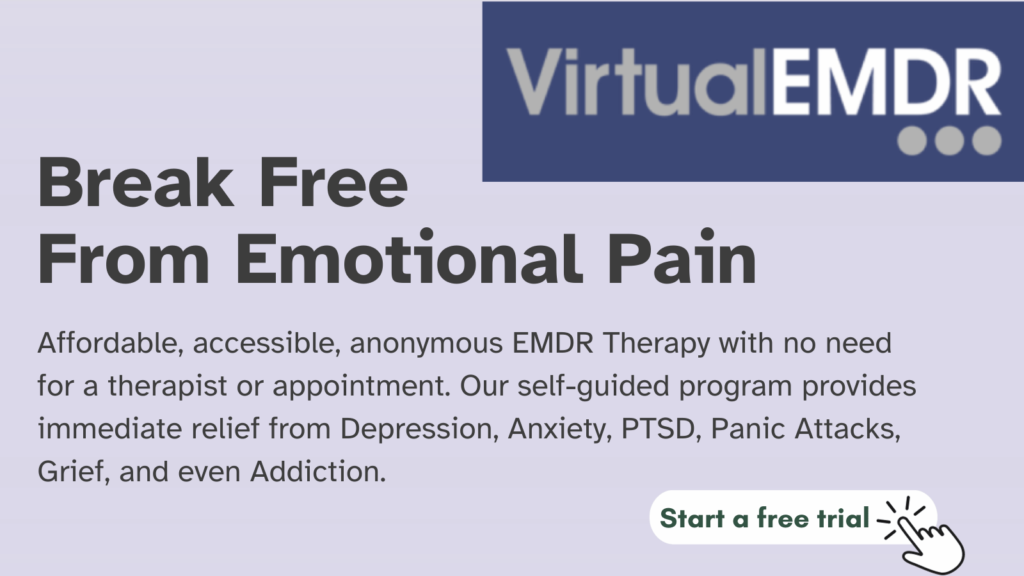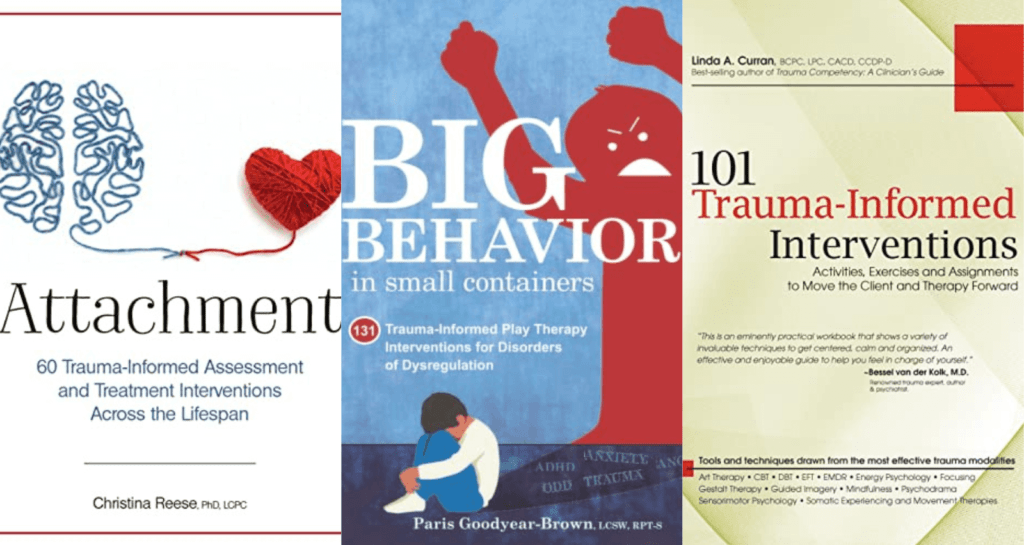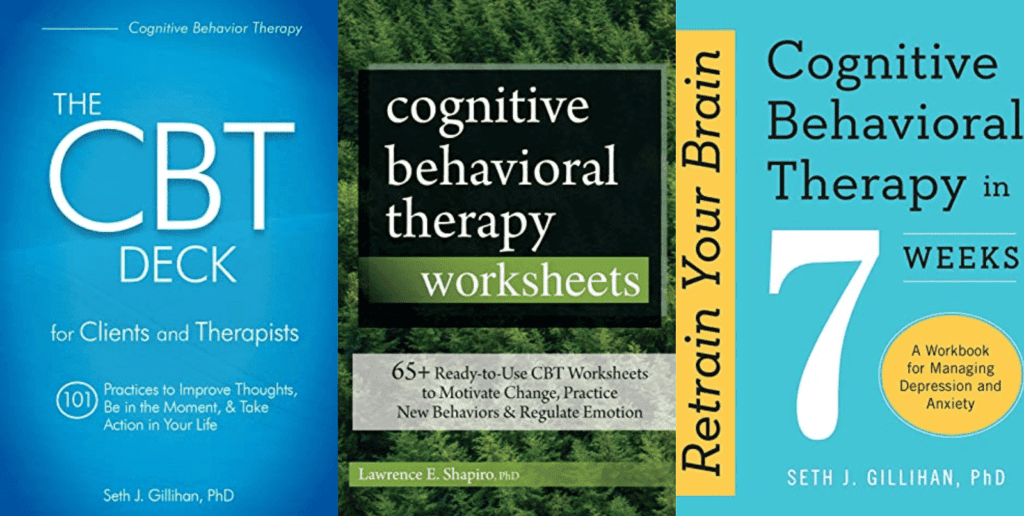The following are some of the best EMDR books.
Disclosure: Some of the links below are affiliate links. This means that, at zero cost to you, I will earn an affiliate commission if you click through the link and finalize a purchase.
What Is EMDR?
EMDR stands for Eye Movement Desensitization and Reprocessing.
It is a therapeutic approach designed to help people overcome the distress associated with traumatic experiences and other emotional difficulties.
During EMDR therapy sessions, trained therapists guide clients through specific eye movements or other forms of bilateral stimulation while addressing their traumatic memories or distressing thoughts.
The goal is to help individuals process and reframe these experiences in a way that reduces their negative impact on their daily lives.
EMDR has been shown to be effective in treating conditions such as post-traumatic stress disorder (PTSD), anxiety, depression, and phobias.
EMDR Books

1. Getting Past Your Past
By Francine Shapiro
Getting Past Your Past offers practical techniques that demystify the human condition and empower readers looking to take charge of their lives.
Shapiro, the creator of EMDR (Eye Movement Desensitization and Reprocessing), explains how our personalities develop and why we become trapped into feeling, believing and acting in ways that don’t serve us. Through detailed examples and exercises readers will learn to understand themselves, and why the people in their lives act the way they do. Most importantly, readers will also learn techniques to improve their relationships, break through emotional barriers, overcome limitations, and excel in ways taught to Olympic athletes, successful executives, and performers.
Related: Brainspotting Vs EMDR (Which One Is More Effective?)

2. Eye Movement Desensitization and Reprocessing (EMDR) Therapy
By Francine Shapiro
Originally developed for treatment of posttraumatic stress disorder (PTSD), this evidence-based approach is now also used to treat adults and children with complex trauma, anxiety disorders, depression, addictive behavior problems, and other clinical problems. EMDR originator Francine Shapiro reviews the therapy’s theoretical and empirical underpinnings, details the eight phases of treatment, and provides training materials and resources. Vivid vignettes, transcripts, and reproducible forms are included. Purchasers get access to a webpage where they can download and print the reproducible materials in a convenient 8 1/2″ x 11″ size.
Related: Brainspotting Risks and Side Effects

3. EMDR Made Simple
By Jamie Marich
EMDR Made Simple: 4 Approaches to Using EMDR with Every Client offers a fresh approach to understanding, conceptualizing, and ultimately implementing EMDR into clinical settings. Dr. Jamie Marich brings in her clinical experience from other modalities and disciplines to show that EMDR is more than just a series of protocols that need to be mastered in order for it to be effective. Using common sense language, clinical cases, and practical examples, EMDR Made Simple will give you the tools to build on your existing clinical knowledge and make EMDR work for you and your clients.
Related: 7 Trauma Release Exercises To Support Your Recovery After Trauma

4. Attachment-Focused EMDR
By Laurel Parnell PhD
Laurel Parnell, leader and innovator in the field of eye-movement desensitization and reprocessing (EMDR), offers us a way to embrace two often separate worlds of knowing: the science of early attachment relationships and the practice of healing within an EMDR framework. This beautifully written and clinically practical book combines attachment theory, one of the most dynamic theoretical areas in psychotherapy today, with EMDR to teach therapists a new way of healing clients with relational trauma and attachment deficits.
Related: Undermothered: How to Mother Yourself Using These Practical 10 Strategies?

5. EMDR: The Breakthrough Therapy for Overcoming Anxiety, Stress, and Trauma
By Francine Shapiro, Margot Silk Forrest
Hailed as the most important method to emerge in psychotherapy in decades, EMDR has successfully treated psychological problems and illnesses in more than one million sufferers worldwide, with a rapidity that defies belief. In a new introduction, Shapiro presents the new applications of this remarkable therapy and the latest scientific research that demonstrates its efficacy.
Related: How To Heal From The Father Wound In 7 Steps (+FREE Worksheets)

6. EMDR Toolbox
By James Knipe PhD
EMDR Toolbox provides an overview of the principal issues in treating these complex emotional problems and describes highly effective methodologies with a wide variety of clinical presentations that originate in or include disturbing traumatic memories. It also describes how to integrate specific EMDR-related interventions with other psychotherapeutic treatments.
Related: Do I Have Trauma? Top 4 Practical Exercises To Support Your Trauma Healing

7. A Therapist’s Guide to EMDR
By Laurel Parnell PhD
A Therapist’s Guide to EMDR reviews the theoretical basis for EMDR and presents new information on the neurobiology of trauma. It provides a detailed explanation of the procedural steps along with helpful suggestions and modifications.
Related: Best 15 Inner Child Exercises: How To Connect With Your Inner Child (& Heal Your Childhood Wounds)

8. Eye Movement Desensitization and Reprocessing (EMDR) Scripted Protocols
By Marilyn Luber PhD
This book serves as a one-stop resource where therapists can access a wide range of word-for-word scripted protocols for EMDR practice, including the past, present, and future templates. These scripts are conveniently outlined in an easy-to-use, manual style template for therapists, allowing them to have a reliable, consistent form and procedure when using EMDR with clients.
Related: Top 25 Inner Child Journal Prompts To Heal Your Inner Wounds
EMDR Workbooks

9. Self-Guided EMDR Therapy & Workbook
By Katherine Andler
Self-Guided EMDR Therapy explores how EMDR can be used to heal emotional disturbances, and what to expect during and after treatment. There are self-help grounding exercises to do before Andler guides readers through each step of the the 8-phase treatment process to healing.
Related: Top 10 Signs Of Toxic Shame In A Person (+Best 20 Healing Shame Exercises)

10. The EMDR Workbook for Trauma and PTSD
By Megan Boardman LCSW
In The EMDR Workbook for Trauma, you’ll discover a complete program to help you get in touch with, understand, and heal from the beliefs, feelings, and bodily sensations connected to your trauma.
You’ll learn to work through past or current trauma using emotion regulation and grounding techniques, and identify the specific triggers, limiting self-beliefs, and symptoms standing in between you and lasting peace of mind.
You’ll also discover how to cultivate compassion for yourself when you’re feeling stuck. Finally, you’ll find tons of tips, tools, checklists, and worksheets to lead you step by step as you process, heal, and journey toward a life free from the effects of trauma.

How EMDR Books Can Help
EMDR books can be a great resource to help individuals understand and explore this treatment method further.
Here’s how EMDR books can help:
1. Education and Understanding: EMDR books provide detailed information about the theory, techniques, and process behind EMDR therapy. They can help you grasp the fundamentals of EMDR and gain an understanding of how it works.
2. Self-Help: Many EMDR books are written with a self-help focus, providing step-by-step instructions on how to apply EMDR techniques on your own. These books can offer practical exercises, strategies, and tools that you can incorporate into your healing journey.
3. Empowerment: EMDR books can empower individuals by helping them take an active role in their healing process. They offer insights into how trauma affects the mind and body and provide guidance on how to regain control and manage symptoms effectively.
4. Personal Stories and Case Studies: Reading about actual experiences of people who have undergone EMDR therapy can be inspiring and reassuring. These stories can offer hope, encouragement, and validation to those seeking healing from similar traumatic experiences.
5. Complementary Techniques: EMDR books often explore other therapeutic approaches and modalities that can complement EMDR therapy, such as mindfulness, meditation, and cognitive-behavioral techniques. They provide a holistic perspective on healing and offer additional tools to enhance the process.
6. Professional Guidance: While EMDR books can be helpful for self-help purposes, they are not a substitute for professional therapy. However, they can give you a better understanding of EMDR therapy, which can be beneficial when working with a trained EMDR therapist. Books can help you get more out of your therapy sessions by allowing you to ask informed questions and actively participate in your treatment.

Conclusion
EMDR (Eye Movement Desensitization and Reprocessing) is a therapeutic approach that can be really beneficial for people who have experienced traumatic events or emotional distress.
Remember that each individual’s journey is unique, and it is essential to consult a qualified mental health professional when seeking therapy or treatment for trauma.
EMDR books can support and supplement the healing process, but they should not be a replacement for professional guidance and care.



